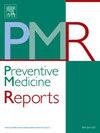美国老年妇女社会资本与乳房x光筛查的关系
IF 2.4
3区 医学
Q2 PUBLIC, ENVIRONMENTAL & OCCUPATIONAL HEALTH
引用次数: 0
摘要
目的探讨美国县级社会资本与老年妇女乳房x光筛查率之间的关系。方法本横断面生态学研究包括2765个美国县,以2018年67-69岁女性医疗保险参保者的县级乳房x光筛查率为结果。社会资本数据来自2018年社会资本项目,包括家庭团结指数、机构健康指数、集体效能指数和社区健康指数。进行多变量对数二项回归分析,以估计“高”乳房x光检查率(全国前10%)的调整患病率(aPRs)和置信区间,控制县级人口统计学和医疗保健协变量。分层分析检验了大都市县和非大都市县之间的关联。结果x线摄影筛查率为17% ~ 64%,平均为41%。在社会资本和乳房x光检查率之间观察到强烈的正相关(Q4 vs. Q1: aPR = 2.29, 95% CI: 1.20-4.36),特别是在社区健康(Q4 vs. Q1: aPR = 1.99, 95% CI = 1.25-3.17)和机构健康(Q4 vs. Q1: aPR = 4.31, 95% CI = 2.40-7.75)方面。这些关联在非大都市县中最强。没有发现家庭团结或集体效能的显著关联。结论县级社会资本,特别是社区和机构卫生,与较高的乳房x线摄影筛查率显著相关,特别是在非大都市地区。这些发现表明,增强公众信任和社区参与可能会改善筛查行为。未来的研究应从多个层面探索社会资本的作用及其对各种癌症筛查行为的影响。本文章由计算机程序翻译,如有差异,请以英文原文为准。
Associations between social capital and screening mammography among older U.S. women
Objective
To investigate the association between county-level social capital and screening mammography rates among older women in the United States.
Methods
This cross-sectional ecological study included 2765 U.S. counties, using 2018 county-level screening mammography rates among female Medicare enrollees aged 67–69 as the outcome. Social capital data were obtained from the 2018 Social Capital Project, including indices for Family Unity, Institutional Health, Collective Efficacy, and Community Health. Multivariable log-binomial regression analyses were conducted to estimate adjusted prevalence ratios (aPRs) and confidence intervals for “high” mammography rates (top 10 % nationally), controlling for county-level demographic and healthcare covariates. Stratified analyses examined associations among metropolitan and nonmetropolitan counties.
Results
Mammography screening rates ranged from 17 % to 64 %, with a mean of 41 %. Strong positive associations were observed between social capital and mammography rates (Q4 vs. Q1: aPR = 2.29, 95 % CI: 1.20–4.36), particularly for the dimensions of Community Health (Q4 vs. Q1: aPR = 1.99, 95 % CI = 1.25–3.17) and Institutional Health (Q4 vs. Q1: aPR = 4.31, 95 % CI = 2.40–7.75). These associations were strongest among nonmetropolitan counties. No significant associations were found for Family Unity or Collective Efficacy.
Conclusions
County-level social capital, specifically community and institutional health, is significantly associated with higher mammography screening rates, particularly in non-metropolitan areas. These findings suggest that enhancing public trust and community engagement may improve screening behaviors. Future research should explore the role of social capital at multiple levels and its influence on various cancer screening behaviors.
求助全文
通过发布文献求助,成功后即可免费获取论文全文。
去求助
来源期刊

Preventive Medicine Reports
Medicine-Public Health, Environmental and Occupational Health
CiteScore
3.90
自引率
0.00%
发文量
353
 求助内容:
求助内容: 应助结果提醒方式:
应助结果提醒方式:


